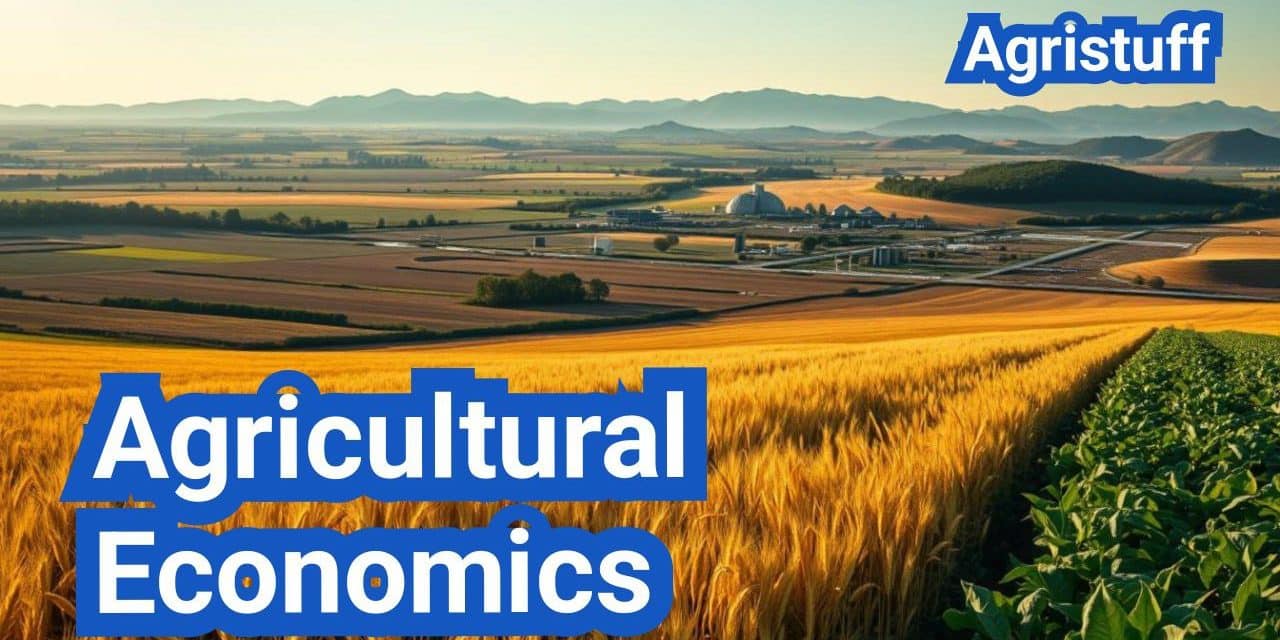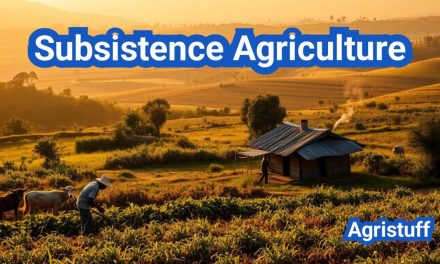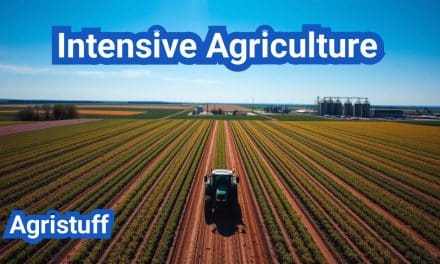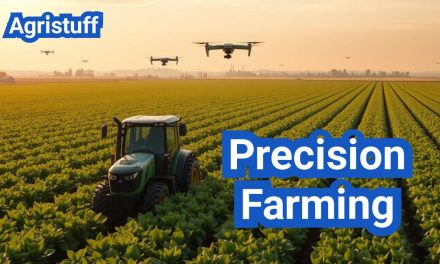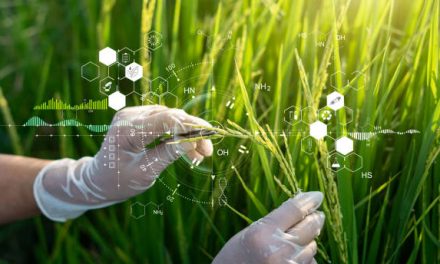Agricultural economics is an applied social science that deals with the production, marketing, and consumption of food and fiber products. It examines how producers, consumers, and societies use scarce resources.
The importance of ag economics lies in understanding the complexities of food production, distribution, and consumption. It plays a crucial role in everyday life, affecting the way we live and the food we eat.
By studying agrarian economics, we can gain insights into the interactions between agricultural production, markets, and the environment.
Key Takeaways
- Understanding the basics of agricultural economics is crucial for making informed decisions.
- Ag economics affects food production, distribution, and consumption.
- The study of agrarian economics provides insights into the interactions between agricultural production and the environment.
- Agricultural economics is an applied social science that deals with scarce resources.
- It plays a significant role in shaping our daily lives and the food we consume.
What Is Agricultural Economics?
Understanding agricultural economics is crucial for addressing the complex challenges facing the global food system. Agricultural economics is a vital field that applies economic principles to the production, distribution, and consumption of agricultural products.
Definition and Scope
Agricultural economics encompasses a broad range of topics related to farming and food production. It involves the study of agricultural markets, trade policies, and the economic factors affecting agricultural productivity. The scope of agricultural economics extends to include the analysis of food security, rural development, and environmental sustainability.
The field is interdisciplinary, drawing on economics, agronomy, and social sciences to understand the complexities of agricultural practices and their impact on society.
Relationship to General Economics
Agricultural economics is closely related to general economics, as it applies economic theories and principles to the agricultural sector. The field examines how economic factors such as supply and demand, prices, and government policies influence agricultural production and consumption.
Historical Development of the Field
The roots of agricultural economics can be traced back to ancient civilizations, with significant developments in the field occurring in the 19th and 20th centuries. The discipline has evolved over time to encompass a broader range of food- and fiber-related activities.
| Period | Key Developments |
|---|---|
| Ancient Era | Early agricultural practices and trade |
| 19th Century | Emergence of agricultural economics as a distinct field |
| 20th Century | Advances in agricultural technology and policy analysis |
The historical development of agricultural economics highlights its evolution in response to changing agricultural practices and economic conditions.
Fundamental Principles of Agricultural Economics

Understanding the fundamental principles of agricultural economics is crucial for analyzing the agricultural sector’s dynamics. These principles guide the decision-making processes of farmers, policymakers, and agribusinesses.
Supply and Demand in Agricultural Markets
The forces of supply and demand are pivotal in determining the prices of agricultural commodities. When demand for a product increases while supply remains constant, prices tend to rise, encouraging farmers to produce more.
Conversely, if supply outpaces demand, prices fall, potentially leading to surplus production. Understanding these dynamics is essential for farmers and agribusinesses to make informed production and marketing decisions.
Resource Allocation and Efficiency
Efficient resource allocation is critical in agricultural economics, as it directly impacts productivity and profitability. Farmers must allocate resources such as land, labor, and capital in a way that maximizes output while minimizing costs.
Agricultural economists study how farmers make decisions about resource allocation, examining factors that influence efficiency and productivity. This includes analyzing the optimal mix of crops, the use of technology, and the adoption of sustainable practices.
| Resource | Allocation Strategy | Impact on Efficiency |
|---|---|---|
| Land | Crop rotation and diversification | Increased soil fertility and reduced pests |
| Labor | Mechanization and training | Improved productivity and reduced labor costs |
| Capital | Investment in technology and infrastructure | Enhanced efficiency and competitiveness |
Risk and Uncertainty in Agriculture
Agricultural production is inherently risky due to factors like weather variability, pests, and diseases. Farmers must manage these risks to ensure stable income and food security.
Agricultural economists analyze risk management strategies, including insurance, diversification, and the use of resistant crop varieties. Understanding these strategies helps farmers and policymakers mitigate the impacts of risk and uncertainty.
Major Branches of Agricultural Economics
Understanding agricultural economics requires delving into its major branches, which provide insights into production, marketing, management, and finance within the agricultural sector.
Agricultural economics is a diverse field that encompasses several key areas of study. These areas are crucial for addressing the complex challenges faced by the agricultural industry, from production to distribution.
Production Economics
Production economics focuses on the optimal use of resources in agricultural production. It involves analyzing the most efficient ways to produce crops and livestock, considering factors like labor, capital, and technology.
For instance, a study on the economics of corn production might examine the impact of different farming techniques on yield and cost. This can help farmers make informed decisions about their production methods.
Agricultural Marketing
Agricultural marketing deals with the processes involved in getting agricultural products from the farm to the consumer. This includes understanding market trends, pricing mechanisms, and distribution channels.
A key aspect of agricultural marketing is analyzing the supply chain to identify areas where costs can be reduced or efficiencies improved. For example, direct-to-consumer sales models can sometimes offer higher margins for farmers.
Farm Management
Farm management involves the application of economic principles to make decisions about farm operations. This includes planning, organizing, and supervising farm activities to maximize profitability.
Effective farm management requires a good understanding of financial management, including budgeting and investment analysis. It also involves managing risk through strategies like crop insurance and diversification.
Agricultural Finance
Agricultural finance focuses on the financial aspects of farming, including access to capital, investment decisions, and risk management. It is crucial for farmers to have access to adequate financial resources to invest in their operations.
Agricultural finance also involves understanding the various financial instruments available to farmers, such as loans and insurance products. This can help farmers manage their financial risks more effectively.
| Branch | Focus | Key Activities |
|---|---|---|
| Production Economics | Optimal resource use in production | Analyzing farming techniques, cost-benefit analysis |
| Agricultural Marketing | Getting products to consumers | Market trend analysis, supply chain optimization |
| Farm Management | Decision-making for farm operations | Financial planning, risk management |
| Agricultural Finance | Financial aspects of farming | Access to capital, financial risk management |
In conclusion, the major branches of agricultural economics are interconnected and crucial for the overall functioning of the agricultural sector. Understanding these branches can help stakeholders make more informed decisions.
Farm Management and Production Economics

Farm management and production economics are crucial aspects of agricultural economics that help farmers make informed decisions. Effective farm management involves the application of economic principles to optimize the use of resources, manage risk, and maximize returns.
Enterprise budgeting is a fundamental tool in farm management, enabling farmers to allocate resources efficiently and prioritize investments. By creating detailed budgets, farmers can identify areas of cost savings and opportunities for growth.
Enterprise Budgeting
Enterprise budgeting involves the estimation of costs and returns associated with specific agricultural enterprises, such as crop production or livestock farming. This process helps farmers to evaluate the profitability of different enterprises and make informed decisions about resource allocation.
| Enterprise | Costs | Returns | Profitability |
|---|---|---|---|
| Crop Production | $100,000 | $150,000 | $50,000 |
| Livestock Farming | $80,000 | $120,000 | $40,000 |
Investment Analysis
Investment analysis is another critical aspect of farm management, involving the evaluation of potential investments in new technologies, equipment, or other assets. By assessing the costs and benefits of different investment opportunities, farmers can make informed decisions that maximize their returns.
Key considerations in investment analysis include:
- Cost-benefit analysis
- Return on investment (ROI)
- Payback period
Risk Management Strategies
Risk management is essential in farm management, as agricultural production is subject to various risks, including weather events, market fluctuations, and disease outbreaks. Effective risk management strategies can help farmers to mitigate these risks and ensure the long-term sustainability of their operations.
Some common risk management strategies include:
- Diversification of crops and livestock
- Use of crop insurance and other risk management tools
- Development of contingency plans for potential risks
Agricultural Policy Analysis
Agricultural policy analysis plays a pivotal role in shaping the future of agriculture. It involves examining the effects of various policies on the agricultural sector, ensuring that stakeholders can make informed decisions. Agricultural policies, both domestic and international, significantly impact the industry.
Domestic Agricultural Policies
Domestic agricultural policies are designed to support the national agricultural sector. These policies can include subsidies, price supports, and regulations on production and trade. For instance, the U.S. Farm Bill is a comprehensive piece of legislation that governs agricultural policy in the United States. It addresses issues such as crop insurance, conservation, and nutrition programs.
Key components of domestic agricultural policies include:
- Subsidies for farmers to support income and manage risk
- Conservation programs to promote sustainable practices
- Regulations on food safety and quality
International Trade Policies
International trade policies affect how countries exchange agricultural products. These policies can influence tariffs, quotas, and other trade barriers. Trade agreements, such as the United States-Mexico-Canada Agreement (USMCA), play a crucial role in determining the flow of agricultural goods across borders.
“Trade agreements can significantly impact agricultural trade by reducing tariffs and other barriers, thereby increasing market access for farmers.”
Policy Impact Assessment
Assessing the impact of agricultural policies is essential to understand their effectiveness and identify areas for improvement. This involves analyzing data on production, prices, trade, and environmental outcomes. Effective policy impact assessment helps policymakers adjust policies to better achieve their goals.
Key considerations in policy impact assessment include:
- Evaluating the economic impacts on farmers and rural communities
- Assessing environmental outcomes, such as soil health and water quality
- Analyzing social impacts, including effects on labor and community development
Agribusiness Economics and Management
Agribusiness economics and management play a crucial role in the modern agricultural industry. Effective management of agribusinesses is essential for ensuring the efficient production and distribution of agricultural products.
Agribusiness Structure and Organization
The structure and organization of agribusinesses can vary significantly, ranging from small, family-owned operations to large, multinational corporations. Understanding the different types of agribusiness structures is crucial for developing effective management strategies.
Some common structures include:
- Sole proprietorships
- Partnerships
- Corporations
- Cooperatives
Supply Chain Management
Supply chain management is a critical component of agribusiness management, involving the coordination of activities from production to distribution. Effective supply chain management can help reduce costs, improve efficiency, and increase customer satisfaction.
Key strategies for supply chain management include:
- Developing strong relationships with suppliers and distributors
- Implementing efficient logistics and transportation systems
- Using technology to track and manage inventory
Marketing and Distribution Strategies
Marketing and distribution strategies are essential for agribusinesses to reach their target markets and customers. Effective marketing strategies can help increase brand awareness, drive sales, and improve customer loyalty.
Some common marketing strategies used in agribusiness include:
- Digital marketing
- Social media marketing
- Trade show marketing
By understanding the principles of agribusiness economics and management, agricultural enterprises can improve their competitiveness and achieve greater success in the marketplace.
Rural Economics and Development

Rural economics and development play a crucial role in shaping the livelihoods of communities worldwide. The study of rural economics encompasses various aspects, including livelihood strategies, community development, and infrastructure economics.
Rural Livelihood Strategies
Rural livelihood strategies are diverse and often depend on the local economic, social, and environmental conditions. Agriculture remains a primary source of income for many rural households, although diversification into non-farm activities is increasingly common.
- Agricultural production and processing
- Non-farm employment opportunities
- Migration and remittances
Community Economic Development
Community economic development initiatives are vital for enhancing the economic well-being of rural areas. These initiatives often focus on creating jobs, improving infrastructure, and supporting local businesses.
| Initiative | Description | Impact |
|---|---|---|
| Local Business Support | Providing financial and technical assistance to local businesses | Job creation and economic growth |
| Infrastructure Improvement | Upgrading roads, utilities, and public facilities | Enhanced quality of life and attractiveness to investors |
Infrastructure and Service Economics
Infrastructure and service economics are critical components of rural development. Investments in transportation networks, telecommunications, and public services can significantly impact the economic viability of rural areas.
Effective rural development strategies require a comprehensive understanding of these factors and their interrelations. By addressing the economic, social, and environmental challenges faced by rural communities, policymakers can foster more sustainable and equitable development.
The Economics of Sustainable Agriculture

As the world grapples with the challenges of climate change and food security, the economics of sustainable agriculture has emerged as a vital area of study. Sustainable agriculture involves practices that are economically viable, environmentally friendly, and socially responsible.
Economic Viability of Sustainable Practices
Sustainable agricultural practices can be economically viable through various means, such as reducing the use of expensive chemical inputs and improving soil health, which can lead to increased crop yields over time. Additionally, sustainable practices can open up new market opportunities for farmers, allowing them to command premium prices for their products.
Key strategies for enhancing economic viability include:
- Diversifying crops and livestock to reduce dependence on a single commodity
- Adopting conservation tillage and other soil conservation methods
- Implementing integrated pest management systems
Environmental Economics in Agriculture
Environmental economics plays a crucial role in sustainable agriculture by assessing the economic value of environmental resources and the impact of agricultural practices on the environment. This field helps in designing policies and incentives that encourage farmers to adopt environmentally friendly practices.
For instance, programs that provide financial incentives for conservation practices or carbon credits for reducing greenhouse gas emissions can make sustainable agriculture more economically attractive to farmers.
Social Dimensions of Sustainability
The social dimensions of sustainability in agriculture involve ensuring that farming practices are socially just and equitable. This includes fair labor practices, supporting local communities, and promoting social cohesion.
Fair trade practices and local food systems are examples of initiatives that enhance the social sustainability of agriculture by ensuring that farmers receive fair prices for their products and that local communities benefit from agricultural activities.
Food Security and Agricultural Economics

Food security, a critical concern globally, is influenced by various factors within agricultural economics. Ensuring that all people have access to sufficient, safe, and nutritious food is a complex challenge that involves economic, social, and political dimensions.
Economic Dimensions of Food Security
The economic dimensions of food security encompass the availability, access, utilization, and stability of food supplies. Agricultural productivity and market efficiency play crucial roles in ensuring food availability and access. Economic factors such as income levels, food prices, and employment opportunities in agriculture significantly impact food security.
| Economic Factor | Impact on Food Security |
|---|---|
| Agricultural Productivity | Increases food availability |
| Market Efficiency | Improves access to food |
| Income Levels | Affects purchasing power for food |
Policy Approaches to Food Security
Policy approaches to food security include a range of strategies such as agricultural subsidies, trade policies, and social safety nets. These policies aim to improve food availability, access, and utilization. Effective policy-making requires a deep understanding of the economic dimensions of food security.
Measuring and Analyzing Food Security
Measuring food security involves assessing indicators such as food availability, access, and nutritional status. Various tools and methodologies are used to analyze food security, including household surveys, food price monitoring, and nutritional assessments. Accurate measurement is crucial for identifying areas of concern and evaluating the effectiveness of policy interventions.
Precision Agriculture and Economic Modeling

Precision agriculture, coupled with advanced economic modeling techniques, is improving decision-making in agriculture. This integration enables farmers to optimize resource allocation, reduce costs, and enhance productivity.
Technology Adoption and Economic Returns
The adoption of precision agriculture technologies, such as GPS-guided equipment and drones, has been shown to generate significant economic returns. These technologies allow for more precise application of inputs, reducing waste and improving crop yields.
| Technology | Economic Return | Adoption Rate |
|---|---|---|
| GPS-Guided Equipment | 15% increase in yield | 70% |
| Drones | 10% reduction in input costs | 40% |
Data-Driven Decision Making
Precision agriculture relies heavily on data collection and analysis to inform decision-making. By leveraging data from various sources, farmers can make more informed decisions about planting, irrigation, and harvesting.
Key data sources include:
- Soil sensors
- Weather stations
- Satellite imagery
Economic Modeling Techniques
Economic modeling techniques are used to analyze the data collected through precision agriculture and predict future outcomes. These models help farmers and policymakers understand the potential impacts of different decisions on agricultural productivity and profitability.
By combining precision agriculture with economic modeling, the agricultural sector can continue to evolve and improve, meeting the demands of a growing global population while minimizing environmental impact.
Global Food Trade Economics

Global food trade economics encompasses the study of international market structures and trade agreements that influence the exchange of food products worldwide.
The global food trade is characterized by complex international market structures that determine the flow of goods across borders. These structures are shaped by factors such as supply and demand, production costs, and government policies.
International Market Structures
International market structures refer to the characteristics of the global food market, including the number of buyers and sellers, the nature of the products traded, and the barriers to entry. Understanding these structures is crucial for analyzing the dynamics of global food trade.
Trade Agreements and Regulations
Trade agreements play a significant role in shaping the global food trade by reducing tariffs and other trade barriers. Regulations, on the other hand, ensure that food products meet certain safety and quality standards.
Managing Market Volatility
Market volatility is a significant challenge in global food trade, as it can lead to price fluctuations and uncertainty. Strategies for managing market volatility include diversification, hedging, and policy interventions.
In conclusion, global food trade economics is a multifaceted field that requires an understanding of international market structures, trade agreements, and strategies for managing market volatility.
Education in Agricultural Economics

The field of agricultural economics is rapidly evolving, and education plays a crucial role in shaping the next generation of professionals. As the agricultural sector continues to face complex challenges, the demand for experts who can analyze and address these issues is growing.
Agricultural economics education encompasses a broad range of topics, from the fundamental principles of economics to specialized courses in agricultural production, marketing, and policy. This education is crucial for developing professionals who can navigate the complexities of agricultural markets and contribute to informed decision-making.
Undergraduate Programs
Undergraduate programs in agricultural economics provide students with a solid foundation in economic theory, statistical analysis, and agricultural practices. These programs typically include coursework in microeconomics, macroeconomics, econometrics, and agricultural economics. Students may also have opportunities to specialize in areas such as agribusiness management or agricultural policy.
Graduate Studies (MA and PhD)
Graduate studies in agricultural economics offer advanced training for those seeking to specialize in research, teaching, or high-level professional positions. Master’s programs typically involve coursework and a thesis, while PhD programs require original research that contributes to the field. Graduate programs often provide opportunities for students to work with faculty on research projects, enhancing their expertise and preparing them for careers in academia or research institutions.
Continuing Education and Professional Development
Continuing education is essential for professionals in agricultural economics, as it allows them to stay current with the latest developments in the field. Workshops, conferences, and online courses provide opportunities for ongoing learning and professional development. Many professional organizations, such as the Agricultural and Applied Economics Association, offer resources and networking opportunities that support continuing education.
In conclusion, education in agricultural economics is vital for developing a skilled workforce that can address the complex challenges facing the agricultural sector. By providing a comprehensive education that includes undergraduate and graduate programs, as well as continuing education opportunities, we can ensure that professionals in this field are equipped to make informed decisions and drive positive change.
Career Paths in Agricultural Economics

With a background in agricultural economics, individuals can pursue careers in multiple industries. Agricultural economics graduates are equipped with a versatile skill set that is valuable in academia, government, and the private sector.
Academic and Research Positions
Many agricultural economics graduates pursue careers in academia, working as professors or researchers at universities. They contribute to the field through research, teaching, and mentoring students. Academic positions often involve publishing research in peer-reviewed journals and presenting at conferences.
Government and Policy Roles
Agricultural economics graduates can also find opportunities in government agencies, where they develop and implement agricultural policies. These roles involve analyzing data, forecasting trends, and advising policymakers. Government positions may be found in departments of agriculture, trade organizations, or research institutions.
Private Sector and Agribusiness Opportunities
The private sector offers numerous career paths for agricultural economics graduates, including roles in agribusiness, financial institutions, and consulting firms. Professionals in these roles might analyze market trends, manage risk, or develop business strategies. Private sector opportunities are diverse, ranging from agricultural production to food processing and distribution.
In conclusion, agricultural economics graduates have a wide range of career options. Whether in academia, government, or the private sector, their skills are in demand. By understanding the various career paths available, individuals can make informed decisions about their professional futures.
Current Trends and Challenges in Agricultural Economics
The world of agricultural economics is experiencing significant shifts due to various emerging trends and challenges. As the global economy evolves, the agricultural sector is faced with complex issues that require careful analysis and strategic planning.
Climate Change Economics
One of the most pressing challenges is climate change, which has profound implications for agricultural productivity and economic stability. Rising temperatures and changing precipitation patterns are altering the conditions under which crops are grown and livestock are raised. Economic models are being developed to understand and mitigate the impacts of climate change on agriculture.
Digital Agriculture and Big Data
The advent of digital agriculture and the use of big data are transforming the agricultural landscape. Technologies such as precision farming, drones, and satellite imaging are enhancing efficiency and productivity. The integration of big data analytics allows farmers to make informed decisions, optimizing resource allocation and reducing waste.
Changing Consumer Preferences
Consumer preferences are shifting towards sustainable and environmentally friendly products, influencing agricultural practices and market dynamics. The demand for organic and locally sourced produce is on the rise, presenting both opportunities and challenges for farmers and agribusinesses. This trend requires adaptations in production and marketing strategies.
Global Market Dynamics
Global market dynamics, including trade policies and international market fluctuations, significantly impact agricultural economics. Trade agreements and tariffs can affect the competitiveness of agricultural products in the global market, necessitating careful policy analysis and strategic planning.
Some of the key trends and challenges are summarized below:
- Climate change mitigation and adaptation strategies
- Adoption of digital technologies in agriculture
- Shifts in consumer demand and preferences
- Global market volatility and trade policy changes
The Future of Agricultural Economics
Agricultural economics plays a vital role in understanding the complexities of the agricultural sector, from production and marketing to policy and trade. As discussed in the preceding sections, the field encompasses various branches, including farm management, agricultural marketing, and agricultural finance.
The future of agricultural economics will be shaped by technological advancements, changing consumer demands, and global market dynamics. As the world’s population continues to grow, agricultural economists will be crucial in addressing the challenges of food security, sustainability, and climate change.
By applying economic principles to agricultural systems, researchers and policymakers can develop effective strategies to improve agricultural productivity, enhance rural livelihoods, and promote sustainable agricultural practices. As the agricultural sector continues to evolve, the importance of agricultural economics will only continue to grow, providing valuable insights into the complex interactions between agriculture, economy, and society.
FAQ
What is agricultural economics?
Agricultural economics is the study of the production, distribution, and consumption of food and fiber products, applying economic principles to understand the complexities of agricultural markets and systems.
What are the key principles of agricultural economics?
The key principles of agricultural economics include supply and demand, resource allocation, and risk management, which are applied to understand agricultural markets and decision-making.
What are the major branches of agricultural economics?
The major branches of agricultural economics include production economics, agricultural marketing, farm management, and agricultural finance, each focusing on different aspects of agricultural economics.
What is the role of agricultural economists in policy analysis?
Agricultural economists play a crucial role in policy analysis by evaluating the impact of domestic and international policies on the agricultural sector, informing decision-making and policy development.
What is the economics of sustainable agriculture?
The economics of sustainable agriculture involves analyzing the economic viability of sustainable practices, environmental economics, and social dimensions of sustainability, aiming to promote environmentally friendly and socially responsible agricultural practices.
What career paths are available in agricultural economics?
Agricultural economics graduates can pursue various career paths, including academic and research positions, government and policy roles, and private sector and agribusiness opportunities.
What education is required for a career in agricultural economics?
Education in agricultural economics typically involves undergraduate or graduate studies in agricultural economics or related fields, with opportunities for continuing education and professional development.
What are the current trends in agricultural economics?
Current trends in agricultural economics include the economics of climate change, digital agriculture, and shifting consumer preferences, which are shaping the future of agricultural markets and systems.
How is agricultural economics research conducted?
Agricultural economics research is conducted using quantitative and qualitative approaches, including econometric modeling, survey research, and case studies, to analyze agricultural markets and systems.
What is the importance of agricultural economics in understanding food security?
Agricultural economics plays a crucial role in understanding food security by analyzing the economic dimensions of food security, policy approaches, and methods for measuring and analyzing food security.
What is precision agriculture and its economic benefits?
Precision agriculture involves the use of technology and data-driven decision-making to improve agricultural productivity and efficiency, with economic benefits including increased yields and reduced costs.
How does global food trade economics impact agricultural markets?
Global food trade economics impacts agricultural markets through international market structures, trade agreements, and regulations, influencing prices, production, and consumption patterns.
Conclusion of: Agricultural Economics
Agricultural economics is an integral branch of economics that deals with the allocation, distribution, and management of agricultural resources. Its central purpose is to optimize productivity and profitability in farming, thus supporting sustainable economic growth and development.
Understanding Agricultural Economics
Agricultural economics involves analyzing how scarce resources like land, labor, and capital are utilized effectively to produce agricultural commodities. By studying these economic dynamics, agricultural economists help farmers, policymakers, and businesses make informed decisions regarding agriculture practices and market participation. [External Link: Food and Agriculture Organization (FAO)]
Significance of Agricultural Economics
The significance of agricultural economics is extensive, covering areas such as crop productivity, resource management, cost reduction, and economic stability. By examining economic activities related to agriculture, the discipline ensures improved livelihoods for farming communities and contributes significantly to global food security. [External Link: International Food Policy Research Institute (IFPRI)]
Major Areas of Agricultural Economics
Key areas of agricultural economics include agricultural policy, farm management, rural development, and agribusiness management. These aspects address critical issues such as subsidies, market dynamics, financial planning, and supply chain efficiency, enhancing agricultural productivity and sustainability. [External Link: Sustainable Agriculture Research and Education (SARE)]
Agricultural Economics and Environmental Sustainability
Sustainability remains a crucial aspect of agricultural economics, emphasizing the balanced utilization of resources to preserve environmental integrity. Practices such as precision agriculture, sustainable farming, and renewable resource management are evaluated to achieve enduring productivity without exhausting natural resources. [External Link: World Resources Institute]
Role in Ensuring Food Security
Agricultural economics significantly contributes to global food security by analyzing food production, market trends, and consumption patterns. Economists formulate strategies to secure adequate food supplies, addressing global hunger and malnutrition challenges effectively. [External Link: World Food Programme (WFP)]
Agricultural Economics in the U.S.
In the United States, agricultural economics profoundly influences both local and national economies. Policies developed from agricultural economic research aid in stabilizing farmer incomes, supporting rural development, and securing national food supply chains. Essential data and policy guidance are provided by institutions like the USDA. [External Link: United States Department of Agriculture (USDA)]
Careers in Agricultural Economics
The field offers diverse career paths such as agricultural economists, policy advisors, agribusiness managers, and rural development consultants. Professionals in these roles contribute significantly to shaping sustainable and productive agricultural practices globally. [External Link: American Agricultural Economics Association (AAEA)]
Future Trends in Agricultural Economics
Agricultural economics continues to evolve, driven by advancements like precision farming, data analytics, and biotechnology. These innovations help economists devise sophisticated strategies to boost agricultural output and sustainability.
Challenges Faced by Agricultural Economists
Agricultural economists face critical challenges such as climate change, resource scarcity, and volatile markets. Addressing these issues requires innovative economic solutions and resilient agricultural practices to maintain stability and productivity. [External Link: Intergovernmental Panel on Climate Change (IPCC)]
Technologies Utilized in Agricultural Economics
Technologies like geographic information systems (GIS), remote sensing, data analytics, and economic modeling play a vital role in modern agricultural economics. These tools enhance decision-making processes and resource management efficiency.
Educational Paths in Agricultural Economics
Educational programs in agricultural economics equip students with knowledge of economic principles, agricultural management, and analytical skills. These programs often include agricultural policy, economics theory, resource management, and practical applications.
Final thought
Agricultural economics is crucial for guiding sustainable and profitable agricultural practices worldwide. It integrates economic principles with practical agriculture, ensuring food security, environmental sustainability, and econ

